Let’s Go to Japan! But first…
The International Date Line
Before we get to the Land of the Rising Sun, we have to talk about the International Date Line. I’m serious. Have you seen it on a map? Who decided an imaginary line separating Today from Tomorrow should zig-zag willy-nilly around the Pacific Ocean like that? Time zone travel is difficult enough in a straight line – this just makes my brain bonkers.
But let’s back up.
All our travels prior to Japan kept us either east or west of the magical divide, and I hadn’t given much thought to the perplexedness of crossing it. Until a flight from Saudi Arabia to Thailand – which goes nowhere near the International Date Line, I know, but nevertheless — my brain works in mysterious ways, especially when I have a map and idle time on my hands...
So, I was sitting there (as one does on an airplane) pondering the general nature of travel, particularly in relation to time zones, the world clock, and how hours are either ‘lost’ or ‘gained’ depending on the direction of travel. From our home point of origin in North America, we’d been in Saudi Arabia long enough to get used to living 8 hours ahead of New York (east coast) and 11 hours ahead of San Francisco (west coast). Once we reached Thailand (which was even farther east than the Middle East), the time difference would increase to 12 and 15 hours, respectively.
The equation was fairly straightforward – the farther east we traveled, the greater the increase in time difference. But then (with time aplenty to dally and wonder) I considered what would happen if we continued heading east. If we skipped Thailand and kept going (like all the way to California). I was visualizing a little plane making its way around the globe like in Indiana Jones — and this is where things got weird.
Because while the physical distance was decreasing (meaning I was getting closer to California), the time difference was increasing.
What the what?
To illustrate this confounding juxtaposition, let’s use Saipan, Mariana Islands in the Pacific Ocean. They’re 17 hours ahead of San Francisco. Compare that to Kwajalein, Marshall Islands, which is actually closer to San Francisco — and yet 19 hours ahead.
It’s mental lunacy.
But weirder still, at some point we would cross the International Date Line and – POOF! – like magic we’d be deposited straight back into Yesterday.
YESTERDAY.
Yep. Because crossing that invisible Bad Boy overrides Father Time and reverses the clock.
And consider yourself warned: it impacts north-south travel, too. If you ever find yourself traveling from Kiribati to Hawaii (both South Pacific islands approximately 1,300 miles apart along the same line of longitude), be sure to book your hotel for Yesterday because you’ll arrive at your destination the day before you left.
Gah!
Everyone properly confused? Rightio – onward to Japan!
Greetings From the Future
Tokyo
Our first (and so far only) trip across the International Date Line occurred without incident (meaning no glitter or confetti floated down from the overhead air vents when we crossed the magic Time Travel line), but we did ‘lose’ a day somewhere along the way. We departed Los Angeles on a Monday afternoon and arrived in Tokyo the following Tuesday evening — just in time for rush hour, so that was fun.
Thank goodness we only had to ‘sardine it’ for two stops down the Tokyo metro line.
Imagine the four of us – with backpack and suitcase each – crammed onto a train already packed to the edges with exceedingly polite and quiet commuters (because that’s how they do things in Japan). And somehow, everyone fits – but it’s an excruciatingly tight fit and there’s absolutely no way in Physics Hell we have to worry about falling over every time the train lurches to a start or stop.
We quickly learned the system: those standing in front of the door step off and move aside for those trapped in the deep interior who need to exit the train. Then the original riders step back aboard and any new arrivals enter after that. And so it goes…always without noise or fanfare. It’s a marvel to behold.
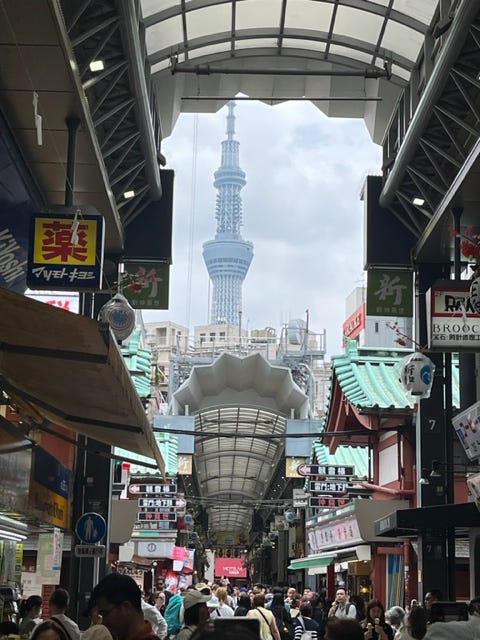
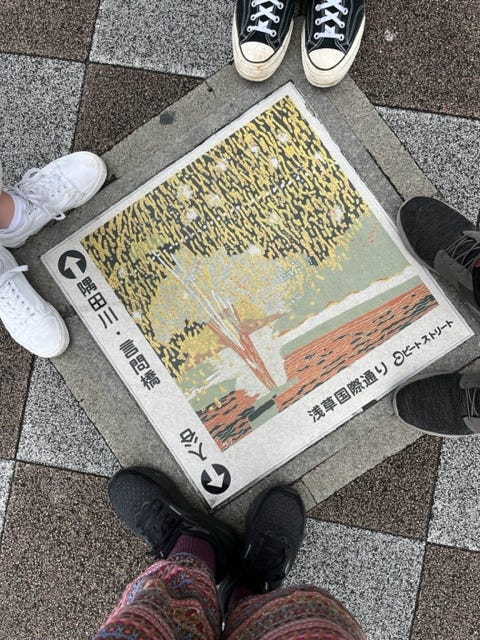
We spent the first three days in Tokyo – a massive city with endless ‘pockets’ to discover – and though we barely scratched the surface, we managed to pack in a variety of experiences while overcoming jet lag — shrines, parks, shopping, bicycle rentals, paddle boats, train stations and endless culinary delights. However, one of the (many) delightful highlights was a visit to Shirohige’s Cream Puff Factory…but you need a little background to appreciate the full experience.
Studio Ghibli
Based in Tokyo, this acclaimed Japanese animation studio creates films (and beloved characters) depicting everyday life in Japan. Their work is a blended mix of fantasy (magic) and realism (food, customs, locations) — and has amassed a huge fan following (including our offspring who enlightened us upon arrival). Some popular film titles include Howl’s Moving Castle, The Boy and the Heron, and Spirited Away. But My Neighbor Totoro is the one you simply must watch before visiting the cream puff factory. Trust me, it will elevate the experience to a whole new level.
Shirohige’s Cream Puff Factory
What you should know: First, it’s less a ‘factory’ and more a quaint and cosy cafe-bakery tucked in a quiet little residential neighborhood in the Setagaya area of western Tokyo. Second, it’s owned by the sister-in-law of famed Studio Ghibli founder and director Hayao Miyazaki, which gives the bakery exclusive rights to produce one-of-a-kind Totoro-themed gifts and treats – most notably (and famously) a daily brigade of Totoro-shaped cream puffs.

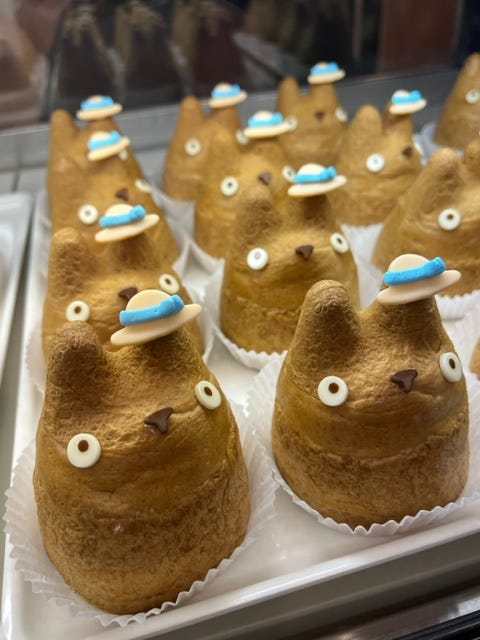
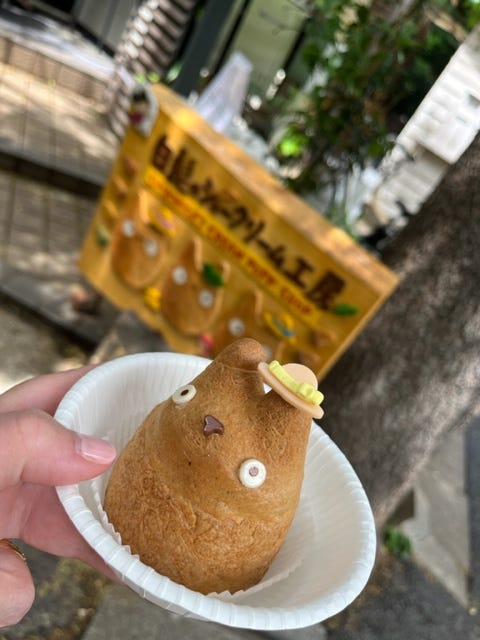
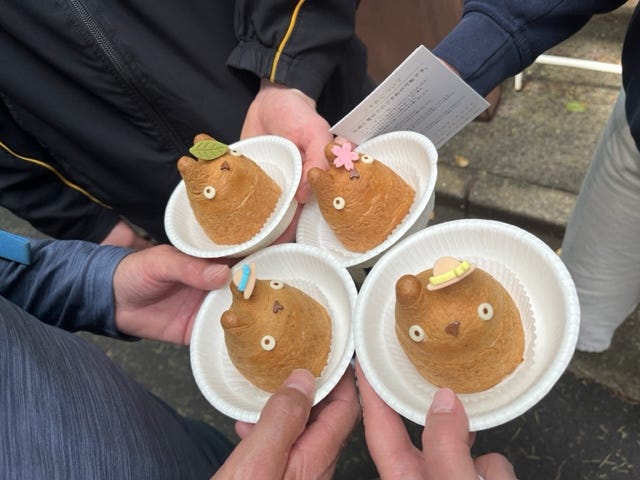
The filling flavors of this day were custard, chocolate, strawberry, and matcha – you bet we ordered one of each to sample – and our taste buds arrived at the same conclusion: they are as delicious as they are adorable.
The bakery and gift shop occupy the ground floor of this tiny, unassuming house. Upstairs, a darling and super compact cafe (four-table-occupancy) serves specialty drinks (coffees and teas) along with a range of food choices (pasta, salads, burgers and sandwiches) – and of course, a full array of baked goods from downstairs.
Customers can eat-in or take-out, but in either case, it’s recommended to arrive earlier than later. There’s usually a line-up — and once an item is sold out, that’s it for the day.
Gotokuji Temple
Before cream puffs and lunch, we coordinated our morning in a ‘nearby’ (a relative term in a sprawling city like Tokyo) part of the Setagaya area, strolling the grounds of the “Lucky Cat” Temple. Known for its collection of famous waving cat figurines (called maneki-neko meaning ‘beckoning cat’), the temple also offers excellent examples of traditional Japanese architecture and well-tended gardens, providing yet another calm oasis in the middle of the big city.
Fortunes & Good Luck Charms
Cats symbolize an enduring legacy of good luck and are, of course, the stars of Gotokuji Temple. In addition to the Maneki-neko figurines and charms (which are said to beckon or invite good luck), visitors have some other options to purchase:
Omikuji (Japanese fortunes) are fun to collect at every temple, but be sure to read it to find out if it’s good or bad! If you receive a ‘good’ fortune, you keep it. If it’s ‘bad,’ you leave it behind, tied to a designated spot.
Ema (wooden plaques) are for writing your wishes and prayers before hanging them on the wall in hopes that your dreams will come true.
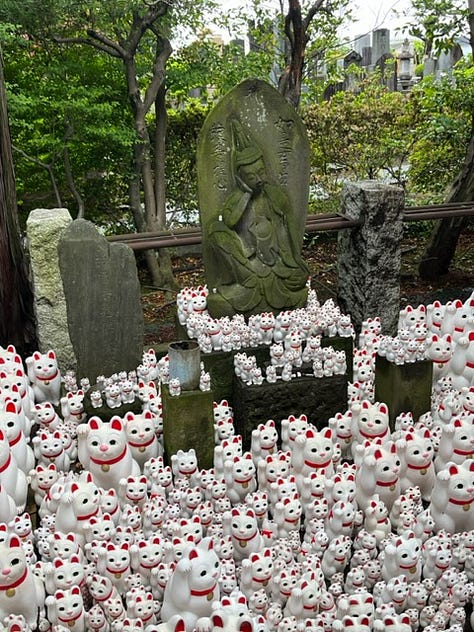
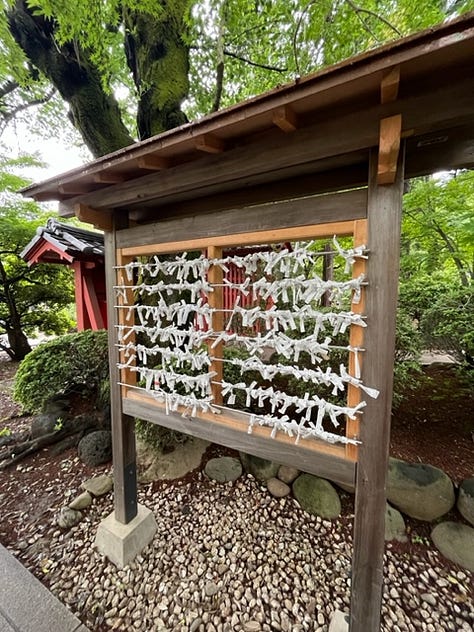
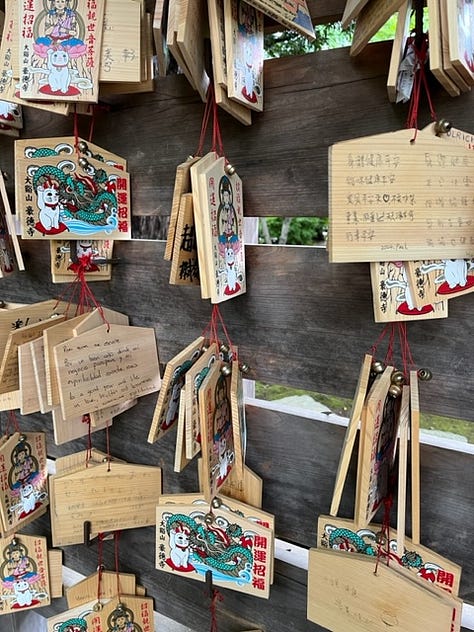
The Nakasendo Samurai Route
Next, we headed off the beaten path to the Kiso Valley, looking to capture the essence of Old Japan. We chose to stay in a traditional ryokan with tatami mats, floor futons, and sliding window screens, but the main attraction was spending a full day walking a 16-kilometer stretch of the historic Nakasendo Samurai Route. It took us through some of the oldest post towns from the Edo period, starting in Magome.
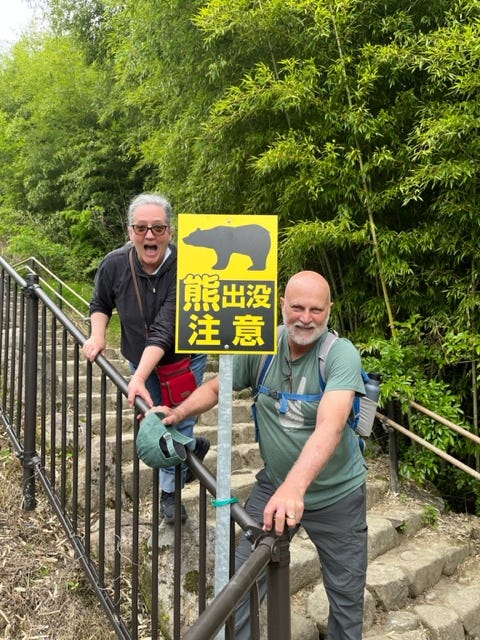
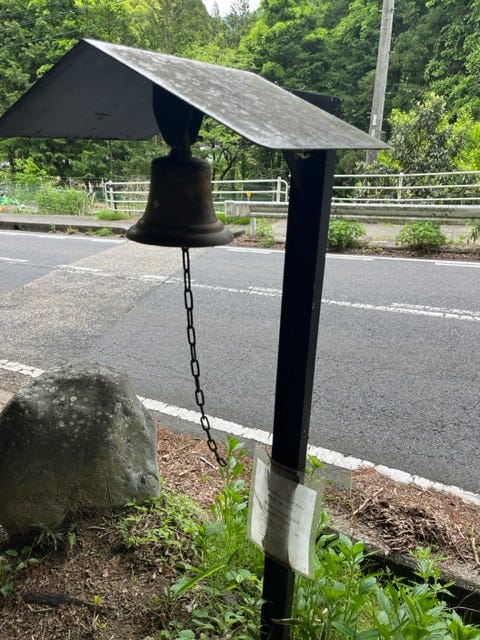
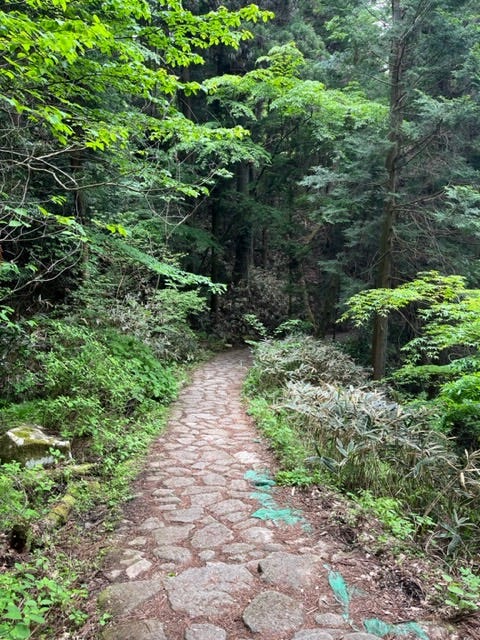
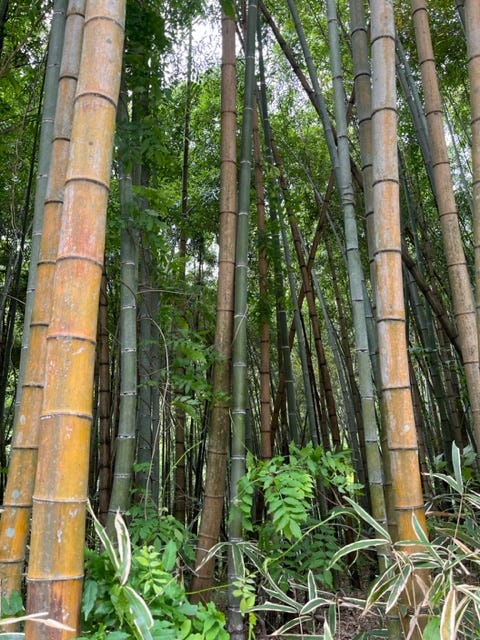
We made our way through the town, past rice fields and captivating lookouts, and then followed the stone path into the forest (noting the bear sign – eek!). We followed the custom of ringing the ‘bear bells’ spaced every few kilometers along the trail to ‘scare’ them away, and I’m happy to report, no bears were sighted, so it must have worked.
Forest ‘bathing’ is a thing here in Japan and it’s easy to see why. Immersing oneself amongst the trees is a magical experience. Sometimes, the evergreen trees gave way to bamboo forests. Sometimes, the stone path through the trees gave way to dirt – and then back to stone again. At one point, I felt like Little Red Riding Hood on the way to Grandma’s house.
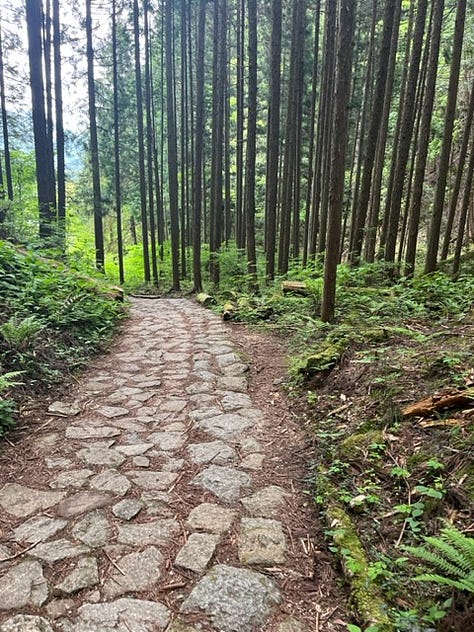
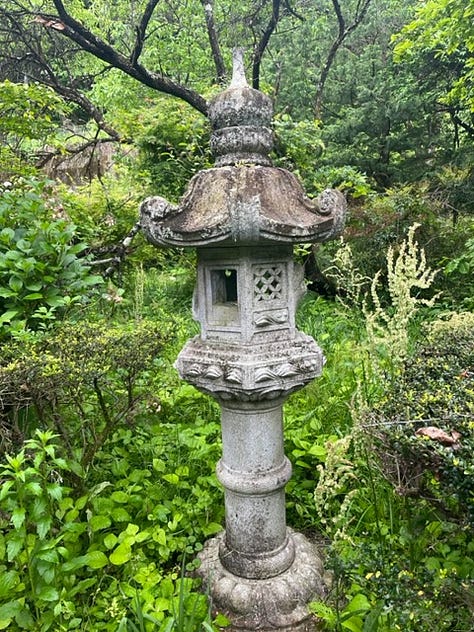
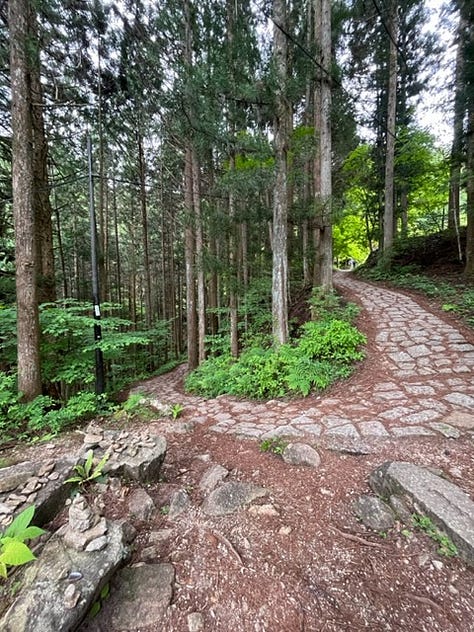
Even out here in nature, away from it all, we met delightful characters — like this gentleman who invited hikers on a ‘scenic tour’ through his whimsical garden.
Or this lone volunteer manning a charming Tea House in the middle of nowhere. Outside, a chalkboard displayed the places of visitors passing by. Inside, free tea and candies were offered to hikers desiring a rest.
Then onward we went through more spectacular nature, past shrines and markers – and more bear bells to ring – before reaching the next post town of Tsumago.
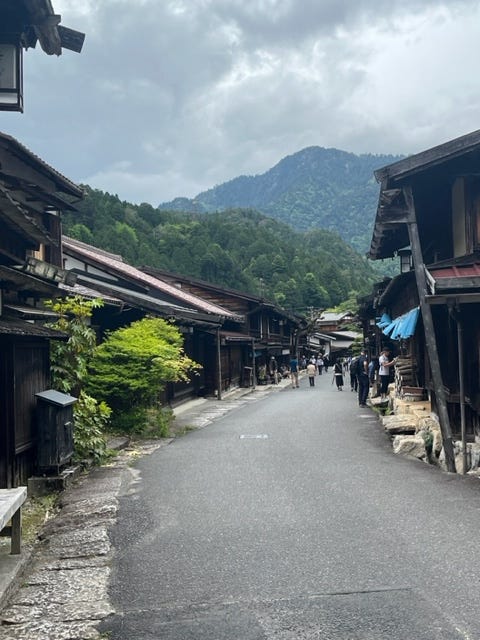
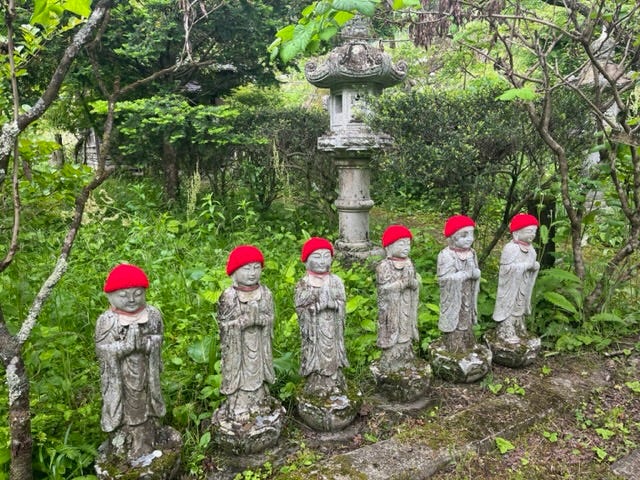
Here, we filled our bellies with Japanese noodles, finished with an ice cream, and then made the final stretch to Nagiso where we caught the train back to Nakatsugawa. A melt-in-your-mouth wagyu beef dinner sealed a perfect day.
Geisha, Gardens & Torii Gates
Next stop: Kanazawa, a charming city along the Sea of Japan – and a treasure trove of sights to rival Kyoto (without the crowds). Here, we visited UNESCO Samurai and Geisha districts, the Kanazawa Castle and adjacent Kenrokuen Gardens (one of the top three in Japan), and rented bicycles for a leisurely jaunt along the river all the way to the sea.
Quick aside: there is so much to love about the food in Japan, but Yakitori (meat on a stick) is one of our favorite food fixes here. And mochi doughnuts for breakfast. Oh, and this city is famous for its gold leaf – which included ice cream – so lucky us!
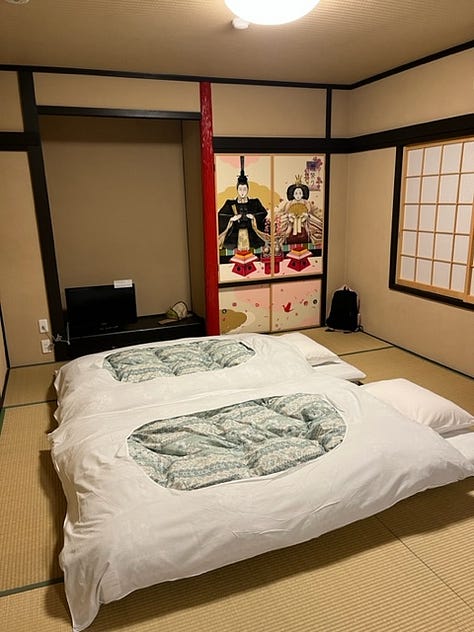
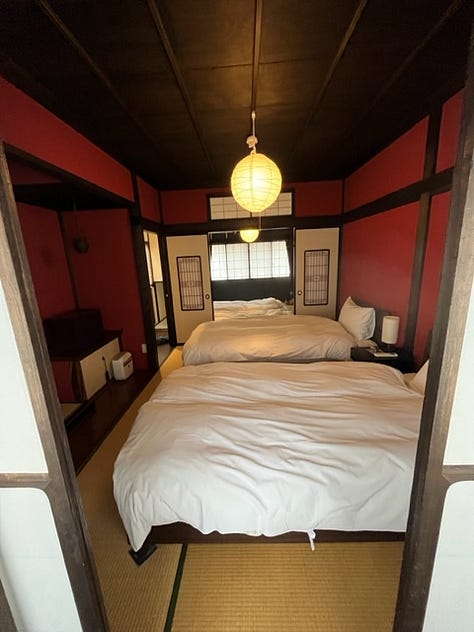
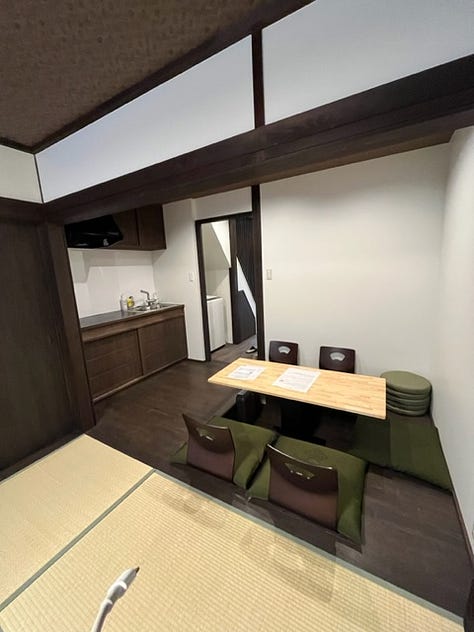
Again, we stayed in a traditional Japanese house: our beds were up off the floor this time (middle picture — which made my KRACKALACKEN knees happy) and the kitchen table, though low to the ground, was fashioned around a sunken area for our feet (another win for the knees).
Nagamachi Samurai District

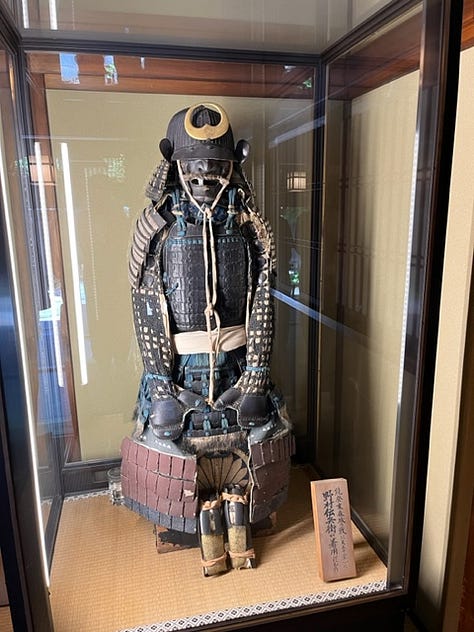
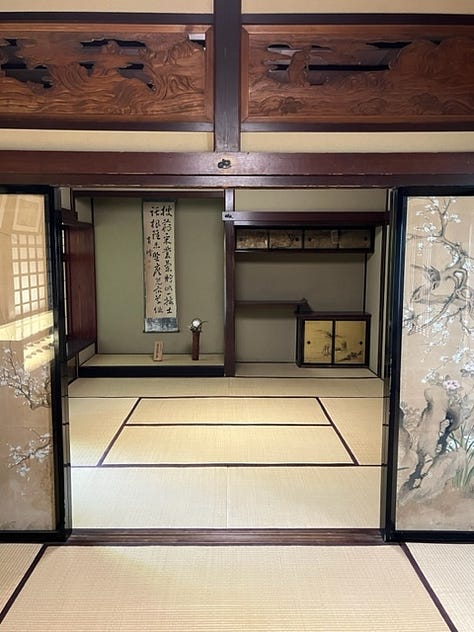
We visited a Samurai house and museum showcasing swords, coins, stirrups and other artifacts. The rooms opened to a Tea Garden and the entire place gave off Shogun (the mini-series) vibes!
Geisha Districts
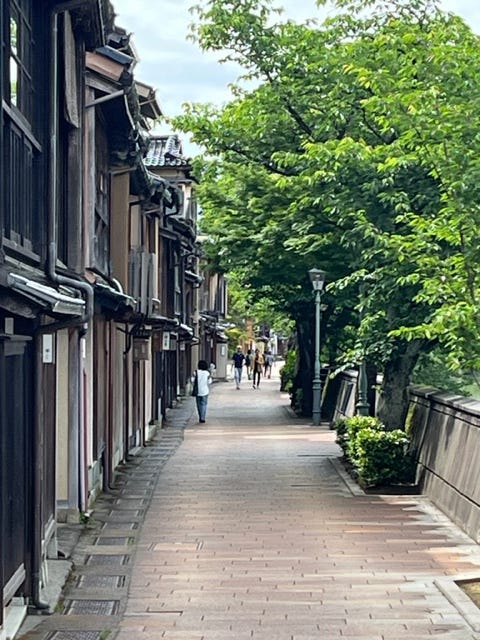
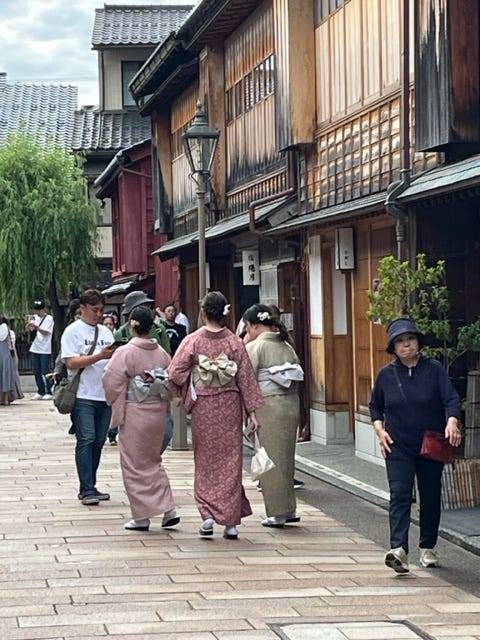
Kazue-machi (left), a smaller Geisha district along the river, and Higashi Chaya Gai (right), the larger and most famous Geisha district in Kanazawa.
Kanazawa Castle & Kenrokuen Gardens

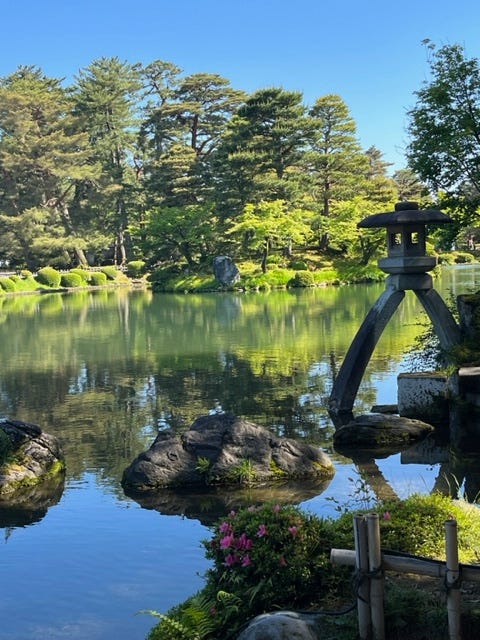
We spent an enjoyable afternoon walking the grounds of the castle (impressive) and adjacent gardens (tranquil, serene, peaceful, contemplative – and bee-yoo-tee-ful!) — that about covers all the descriptors you’d expect in Japan — where we discovered a statue of Takeru no Mikoto, a legendary figure of Japanese mythology (similar to King Arthur), and a fountain with a sign proclaiming it the oldest in Japan!
Ishiura Shrine
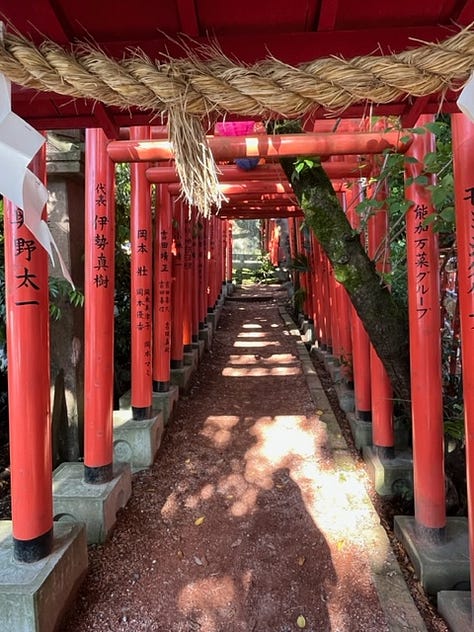
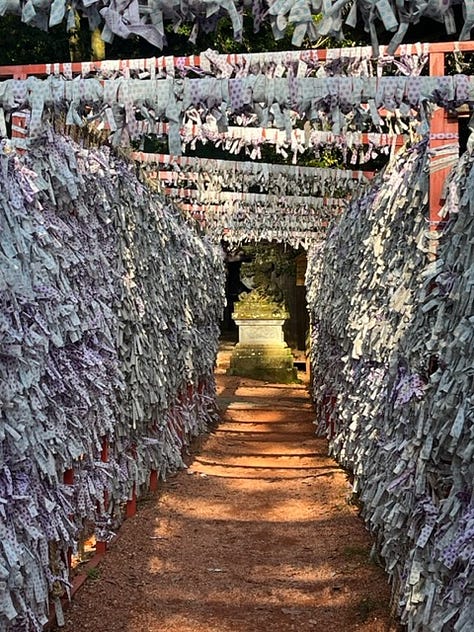
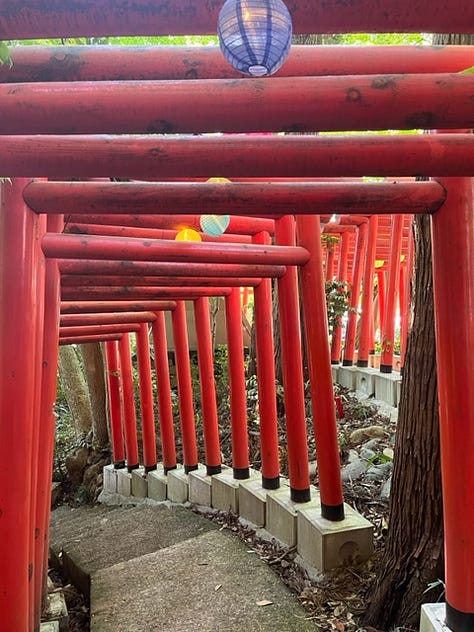
Nearby, we stumbled upon the oldest Shinto shrine in Kanazawa, built over 1500 years ago. It includes 101 vermilion Torii gates, colorful paper lanterns, and a fortune tunnel tied with thousands of pink and purple polka-dotted omikuji. The dotted pattern represents the belief that everything comes full circle and symbolizes “all is well.” Also, this is the shrine to visit if you’re looking for a soulmate – it’s famous for its association with good luck in romance (wink, wink).
Torii Gates
These traditional Japanese gateways are most commonly found at entrances to Shinto shrines and serve as a symbolic boundary between the mundane and sacred worlds. Often they are painted a reddish-orange color (vermilion), which is thought to ward off evil spirits and disasters, but they can also be left in their natural wood, stone or concrete states, depending on the shrine’s tradition and local customs.
Oh My Deers!


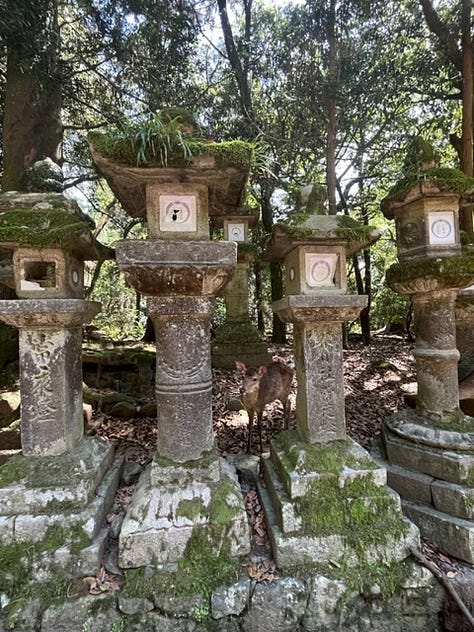
Nara, Japan’s former capital city, is home to some significant 8th century temples and artwork – but its most beloved feature is a creature: free-roaming deer who bow for special deer cracker offerings. You’ll see them everywhere as you explore forested parks, temples, and even a few quaint city alleyways.
Hiroshima
On August 6, 1945, the city of Hiroshima was devastated by the dropping of the first atomic bomb. Today, this resurrected city embodies the spirit of resounding peace: everywhere, monuments stand, serving as reminders of enduring grief and the atrocities of war – and also as beacons of hope, distilling a yearning for genuine and lasting world peace.
But is the world listening?
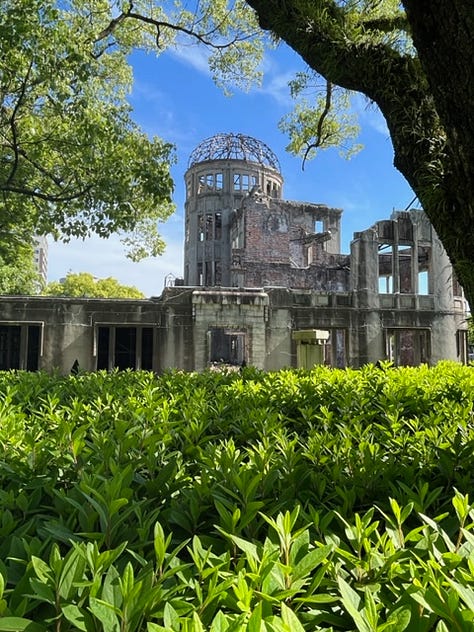
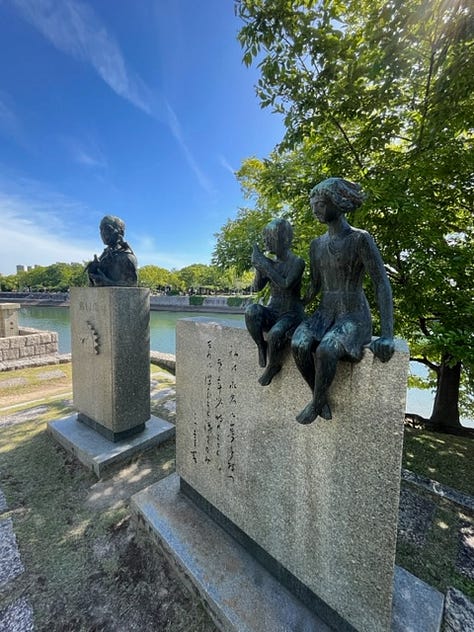
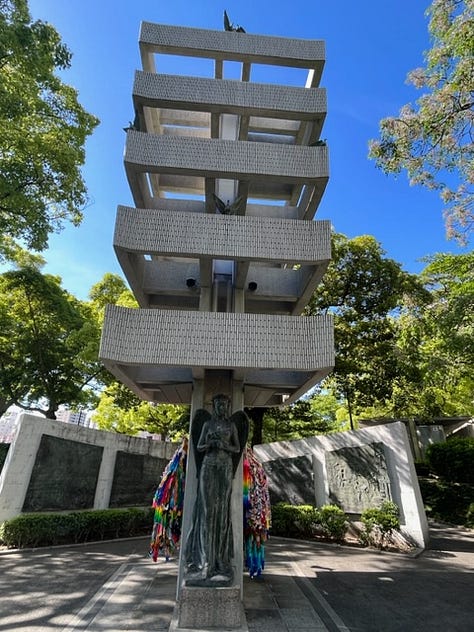
Hiroshima Peace Memorial, Genbaku Dome
“As a historical witness that conveys the tragedy of suffering the first atomic bomb in human history and as a symbol that faithfully vows to seek the abolition of nuclear weapons and everlasting world peace, Genbaku Dome was added to the World Heritage List, December 7, 1996.”
Red Bird Monument
Miekichi Suzuki, a distinguished novelist known as ‘The Father of Children’s Literature,’ launched a children’s literacy magazine which introduced the first songs and fairytales for children in Japan. This monument, built in 1964, serves as a symbol of Hiroshima’s recovery from the devastation of the atomic bomb and the hope for world peace.
Memorial Tower to the Mobilized Students
The sculpture at the base depicts the Goddess of Peace accompanied by 8 doves perched around the tower in memory of the students (over 12 years of age) who sacrificed their lives to join the labor force during World War II.
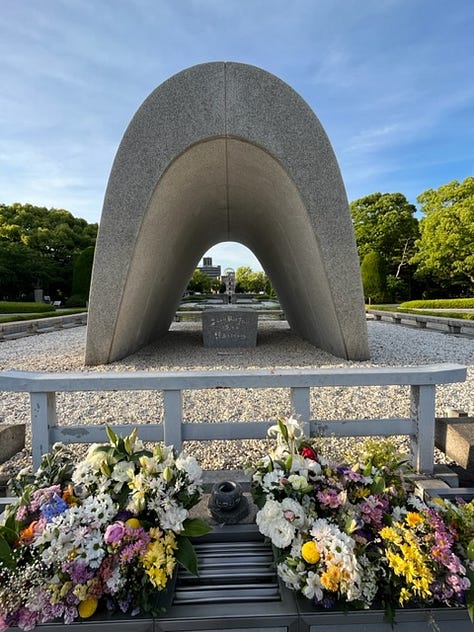
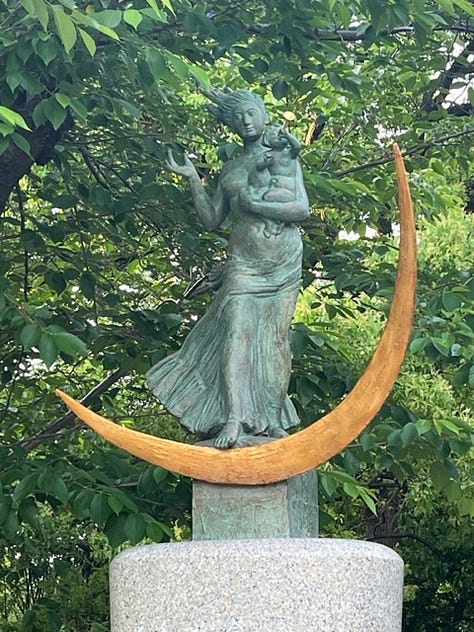
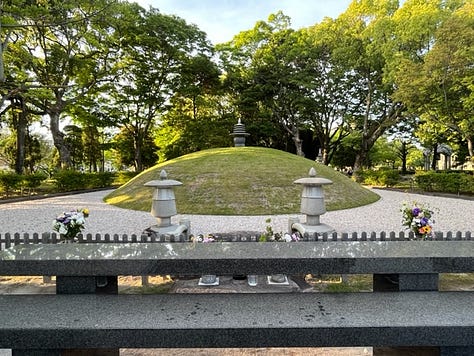
Memorial Monument for Hiroshima, City of Peace
The stone chamber contains the Register of the Deceased A-Bomb victims. The inscription on the front panel offers a prayer for the peaceful repose of the victims and a pledge on behalf of all humanity never to repeat the evil of war.
Mother and Child Statue of a Prayer for Peace
Forever and always.
Atomic Bomb Memorial Mound
The ashes of tens of thousands of victims are laid here.

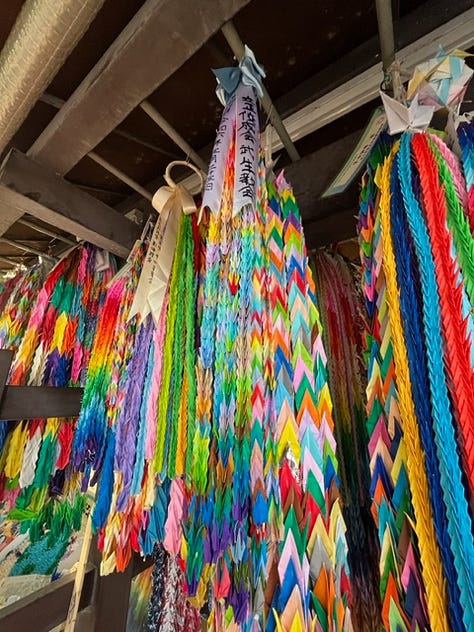
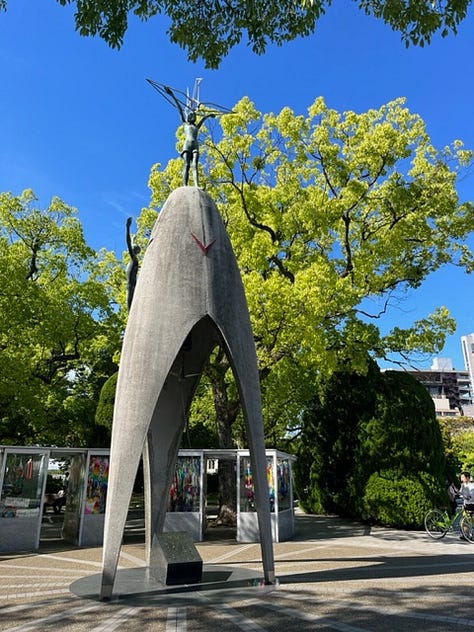
Monument to Korean Victims and Survivors
Did you know? Of the 200,000 Hiroshima citizens lost to the bomb, approximately 10% were Korean.
Children’s Peace Monument
This monument stands in memory of all children who died as a result of the atomic bombing of Hiroshima. At the top, a bronze statue of a young girl lifts a golden crane entrusted with dreams for a peaceful future. Inscribed on the bell: A thousand paper cranes. Peace on Earth and in the Heavens.
Significance of the Crane
In Japan, the crane is a national treasure and considered the bird of happiness. It has become a symbol of peace, hope, and healing. The Japanese believe anyone with the patience and commitment to fold 1,000 origami paper cranes will be granted a wish and given good fortune.
Meet Sadako Sasaki
The Children’s Peace Monument was originally inspired by the death of Sadako Sasaki (1943-1955) who was exposed to radiation from the atomic bomb at the age of two. Ten years later, she developed leukemia and was hospitalized for treatment. After learning about the legend of the thousand paper cranes from her father, she attempted to fold 1,000 cranes from her hospital room in hopes that her wish would be granted.
Sadako folded 644 cranes before she died.
Her classmates folded the remaining 356 cranes so that 1,000 in total would be buried with her. The book, Sadako and the Thousand Paper Cranes, by Eleanor Coerr, is a poignant story based on her life.
Sayonara, lovely Japan!
From bullet trains to bicycle rides to bowing deer – and ALLLL the amazing food encounters – this trip was one for the books.
As for that day we ‘lost’ on the way over? Well, we found it on the flight back to North America. Don’t ask me how it works, all I know is we spent our FIRST full Tuesday in the zen-like peace of Tokyo, flew 10 hours overnight, and arrived in gritty, loud Los Angeles in the morning of the same day we left. So we got to spend our SECOND Tuesday in a mini mind fog, loitering McDonald’s and Starbucks on our hotel block in a west LA barrio near LAX until we could check in.
Time Travel is exhausting. It was time to get back to our own peaceful island — where a lesson in growth mindset preempted an important mission...
1,000 Paper Cranes: A Wish for Health & Peace
I have always loved origami paper cranes – and I admire people (like my daughter) who can whip one up in ten crisp nano-seconds. I’ve tried. Oh, I’ve tried. But no can do.
Even with diagrams and step-by-step instructions, anything beyond the basic ‘mountain’ or ‘valley’ fold is incomprehensible to me. For example, those little arrows and swirly-ques? No clue what they’re implying I’m supposed to do to the paper. Unless it’s one of those cootie-catchers or a crumpled paper ‘snowball,’ there’s a good chance I’ll lack the spatial reasoning to turn a flat square into anything 3-dimensional – much less an adorable paper crane.
But then we went to Japan and I was inspired anew! (I even bought a small pack of gorgeous origami paper while I was there…)
Consequently, when we returned home I decided to teach myself (once and for all) how to fold a paper crane – and I was determined to figure it out the old-fashioned way: via paper instructions.
Well, I started off all right…until I got to the part that told me to ‘pocket fold’ or ‘inside-reverse-fold’ the head and tail.
Grrr. My brain wanted to explode.
Still I refused to watch a video tutorial (I know! Insert eye roll because what is wrong with me???) — instead I hunkered down with stubborn resolve to work through this spatial block. I crumpled, creased and tore my way through one square sheet after another…until my lopsided, crinkled, malformed attempts started to resemble a crane. I was getting close!
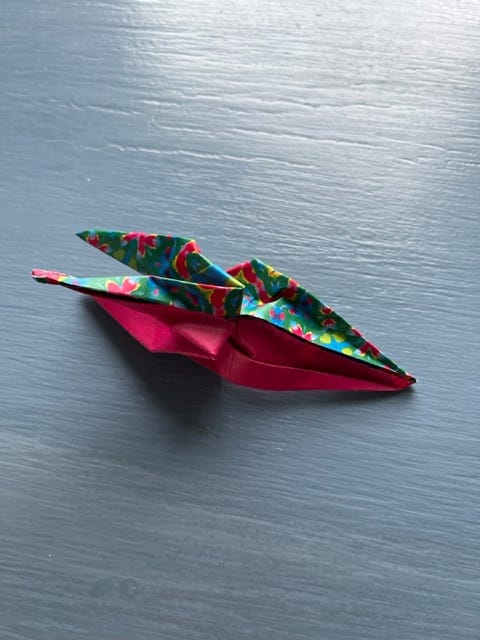
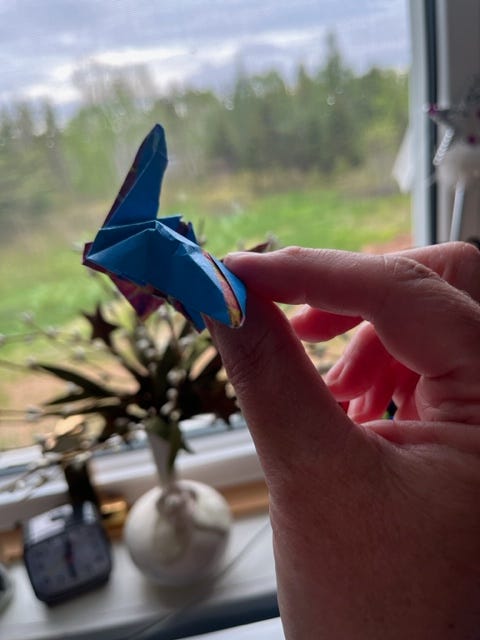
I kept tweaking. Adjusting. Starting over — then EUREKA! Those final annoying steps finally clicked. At last I ‘got’ it! And guess what? After that, I didn’t even NEED directions!
This launched me on an origami crane folding spree – just for fun – but in the midst of my little growing pile of cranes, I heard my neighbor’s devastating news: her cancer (a rare form of leukemia we all thought she had kicked to the curb) had returned with a vengeance and she had to go back into the hospital. In Halifax. For an indeterminate amount of time — the treatments would be aggressive and the doctors said she would likely be there for months.
You all. One rogue blood test and her life was disrupted all over again. The parallels to Sadako Sasaki were not lost on me. I recalled the legend of the thousand paper cranes and refused to give up hope.
A community initiative was born.
We organized a series of paper crane folding workshops and invited all ages to come and help with the mission. The turnout varied — from modest to mighty — but people always showed up. We served tea and snacks and graphed our progress on a chart. Others helped from home.
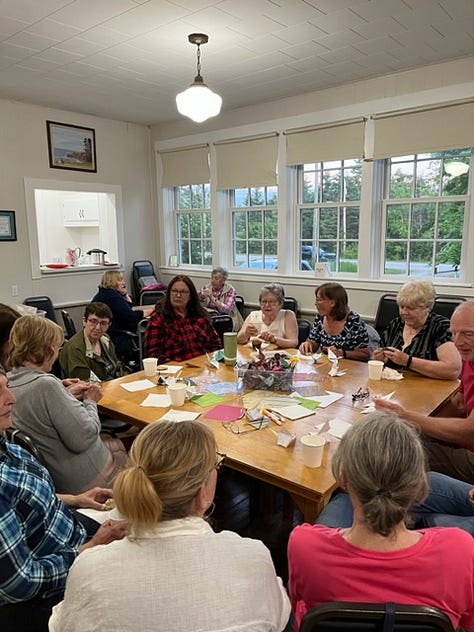
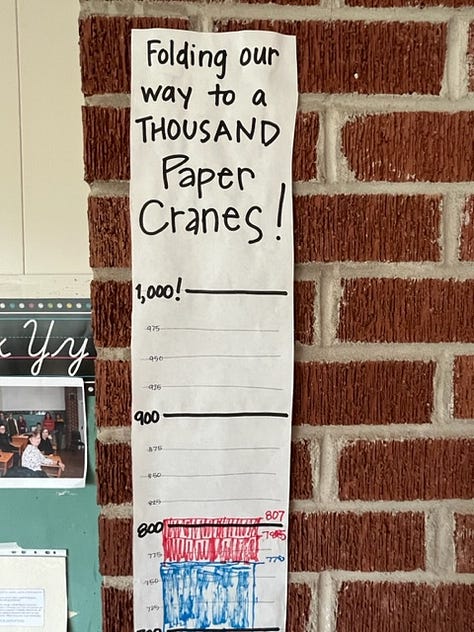
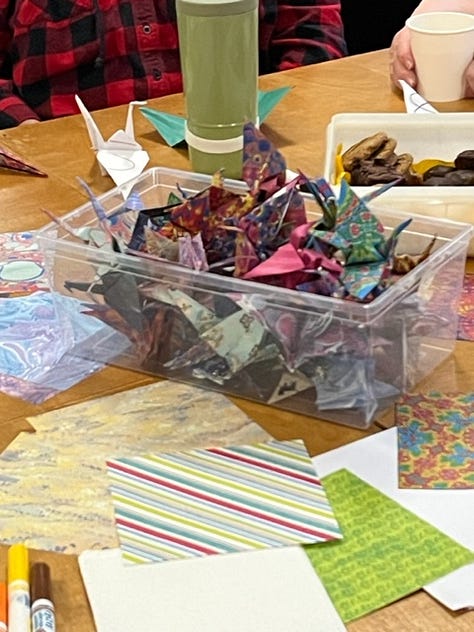
And we continued to fold and fold and fold.
The cranes began to pile up, each one carrying a wish, a prayer, an intention on behalf of our neighbor’s health and recovery.
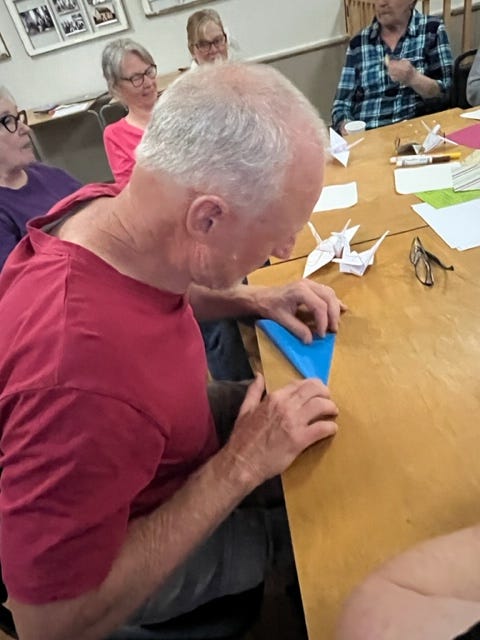

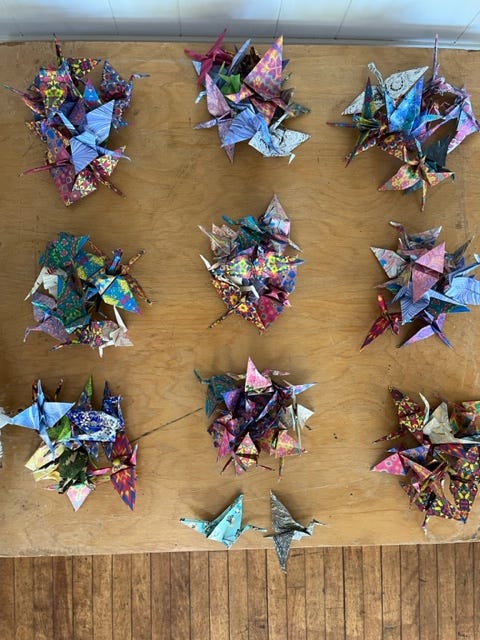
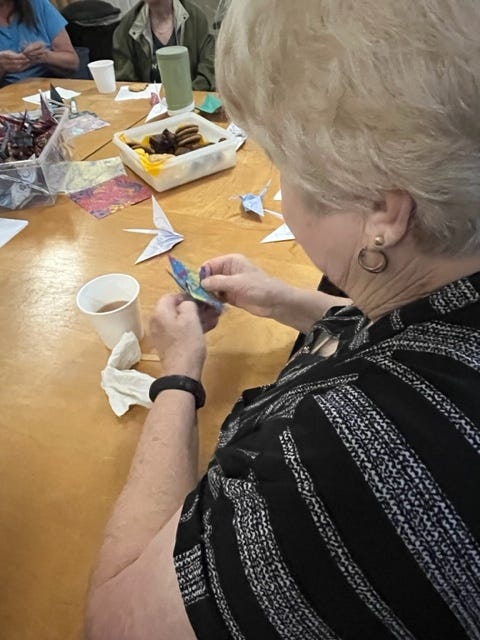
One gentleman, brand new to paper crane folding, learned how in the first workshop, and then went home and folded close to 400 cranes on his own. A friend in the States wanted to contribute and sent me a folded crane fleet by mail. And bags of cranes kept trickling in from the community — 10, 50, 100 at a time.
In two months, we reached our goal: 1,000 paper cranes!
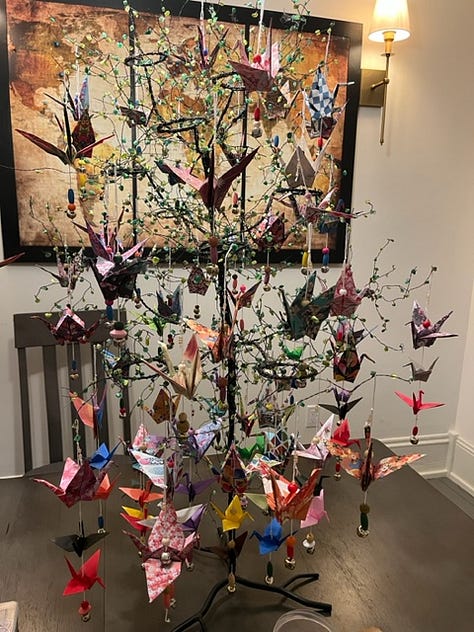
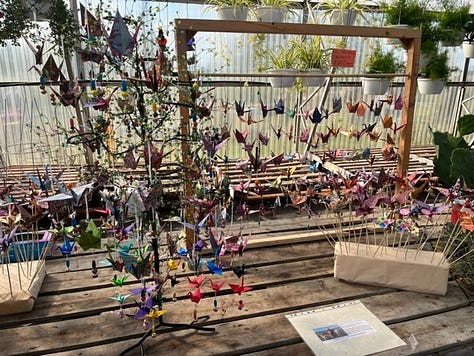
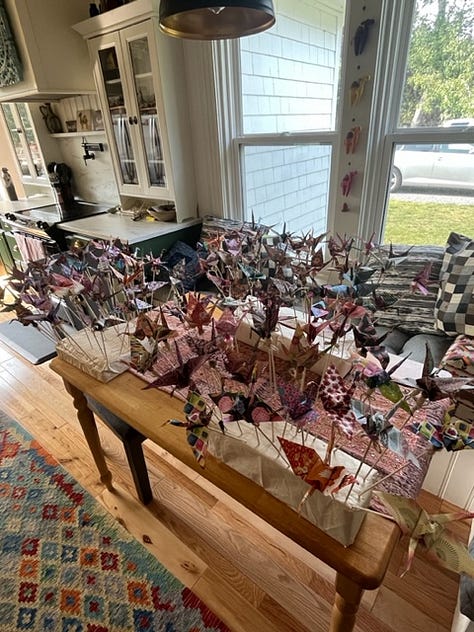
Next, we turned the cranes into adorable plant stakes, charms and window mobiles so we could share them with the wider community. We put them up for adoption by donation and raised close to $2,000, every penny going directly to our neighbor to assist with her medical expenses.
I wish I could say the legend worked its magic, but similar to Sadako’s fate, my friend Katrin passed away earlier this year after her second ferocious battle with cancer. At her Celebration of Life, we handed out paper cranes in her memory –
for love
for peace
for friendship
for healing
for hope
for our future.
Until next time, I’ll continue folding paper cranes. Because I still believe in all those things.
~ Kathy XX




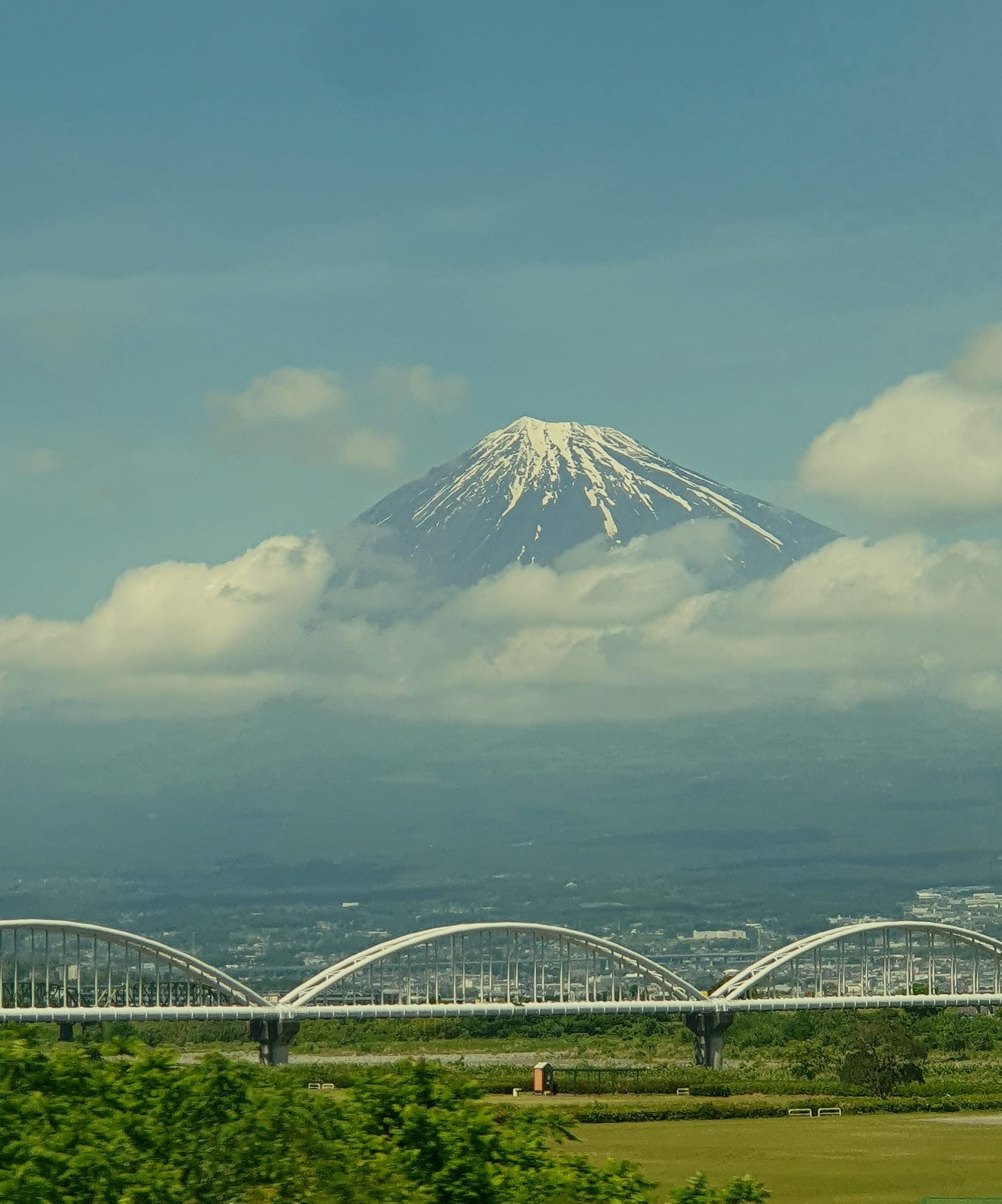
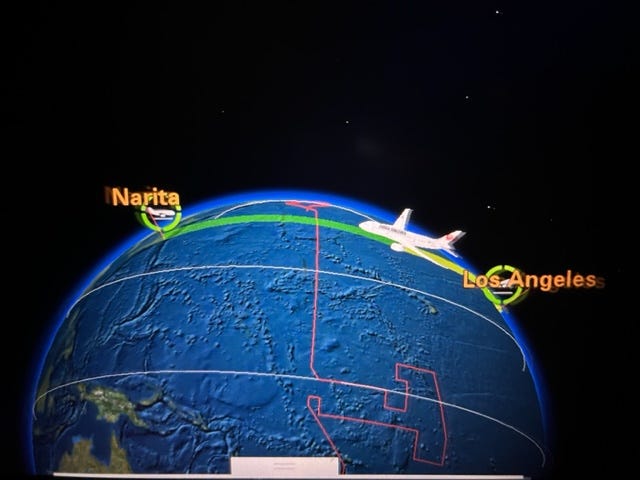
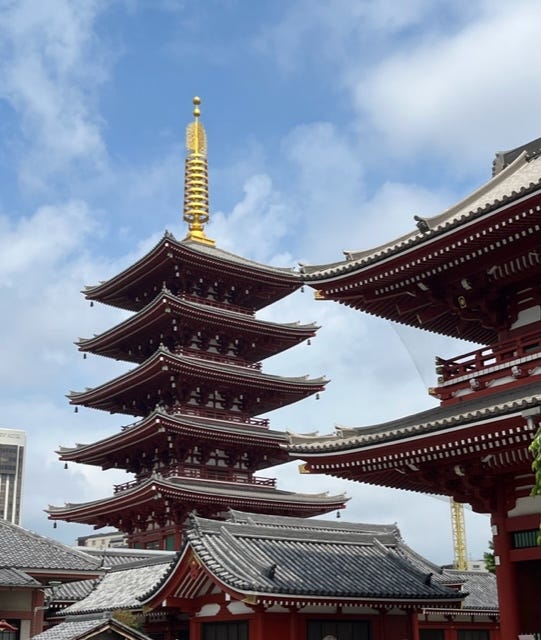

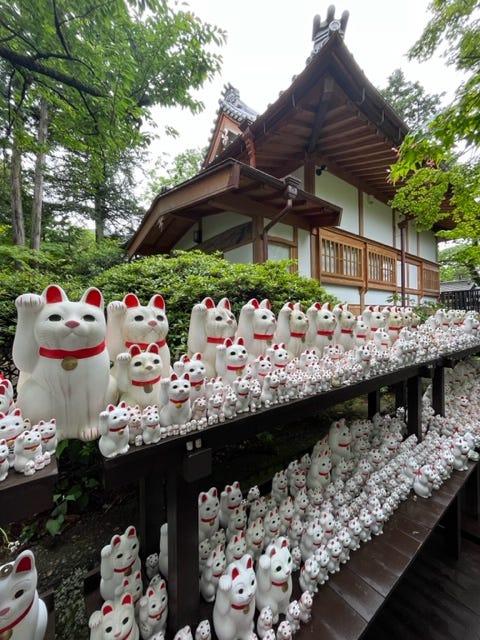
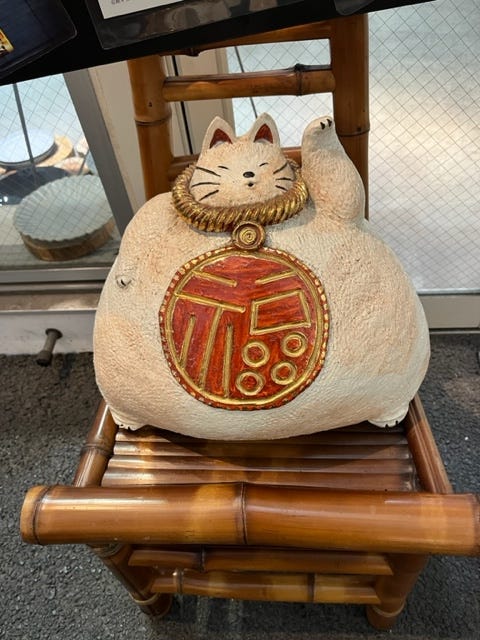
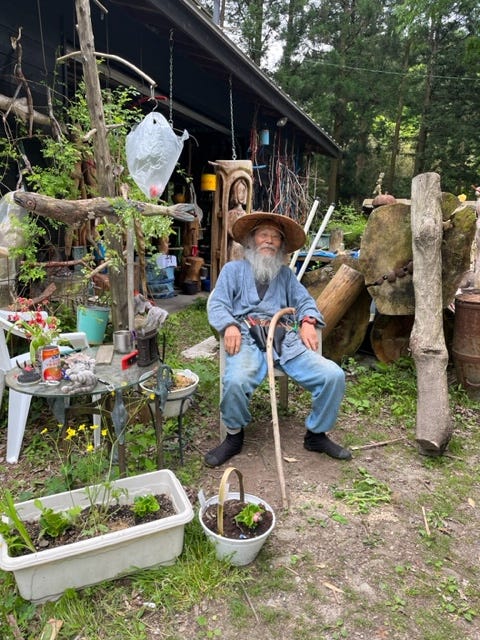
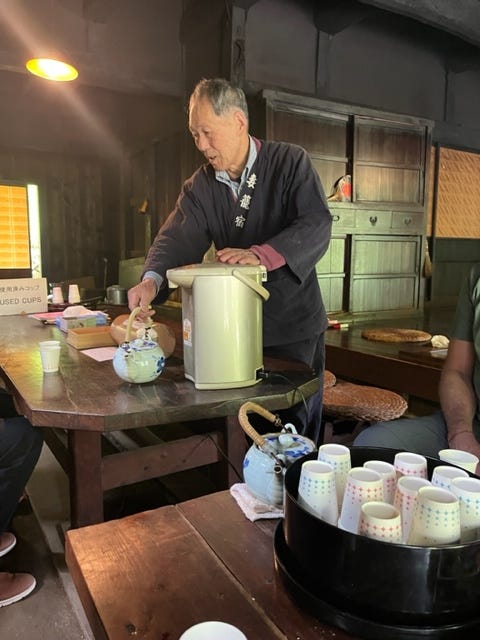

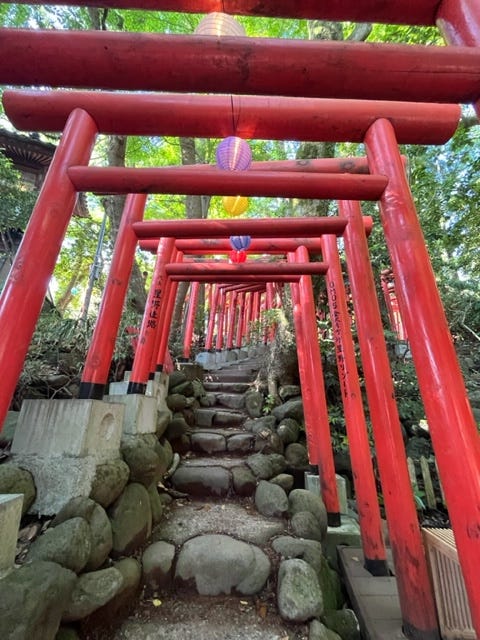

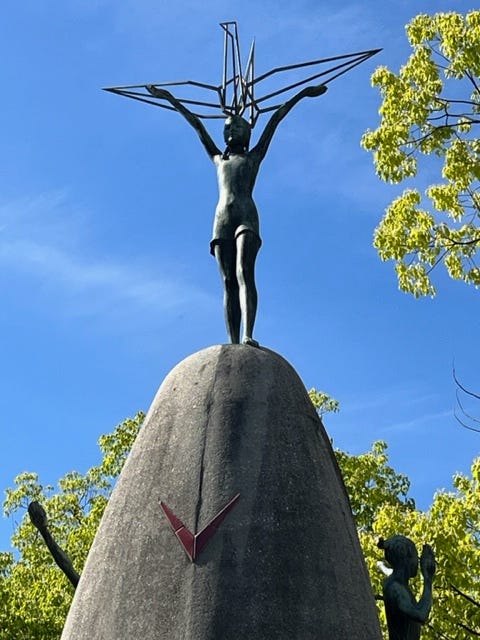
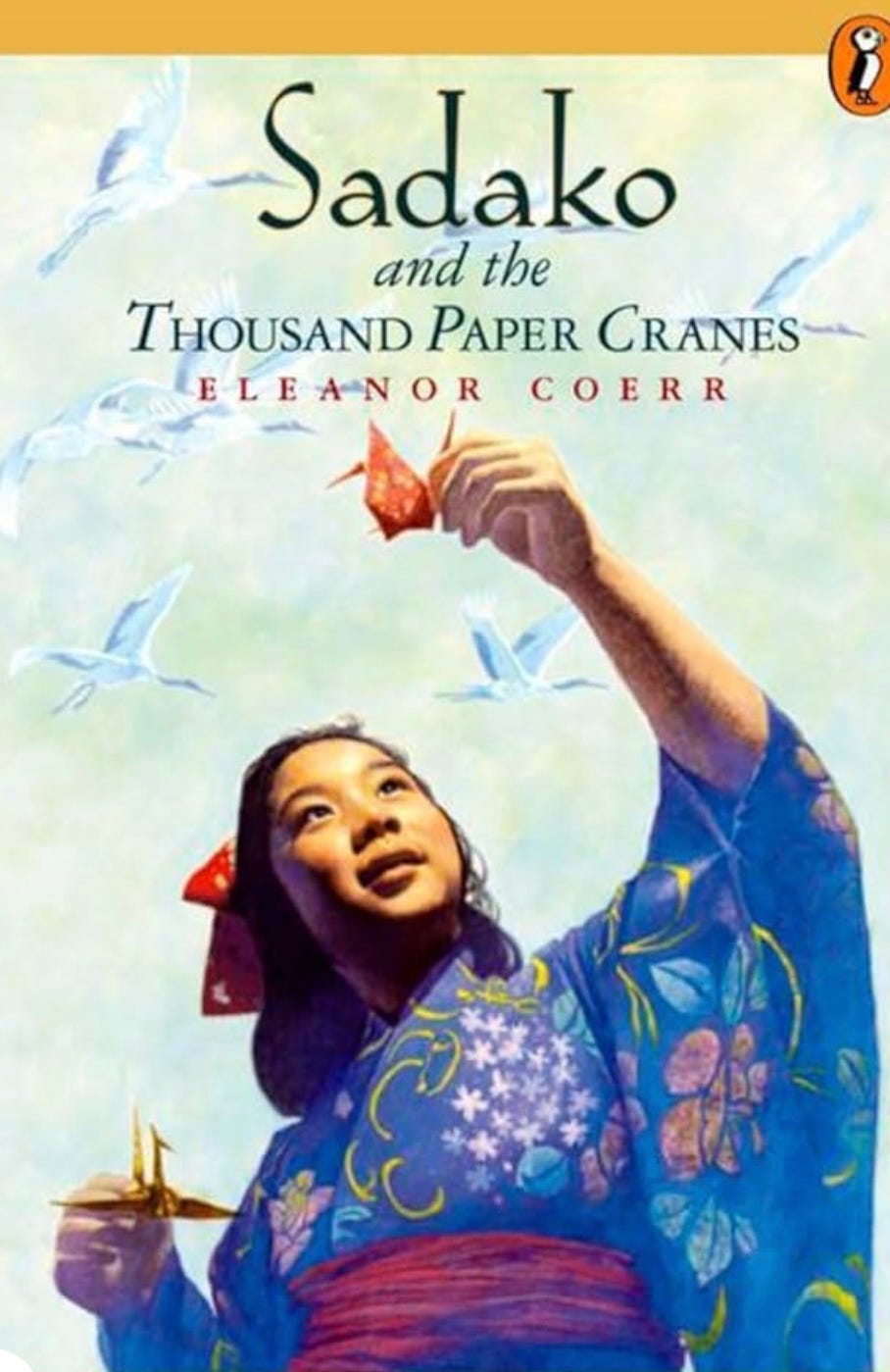
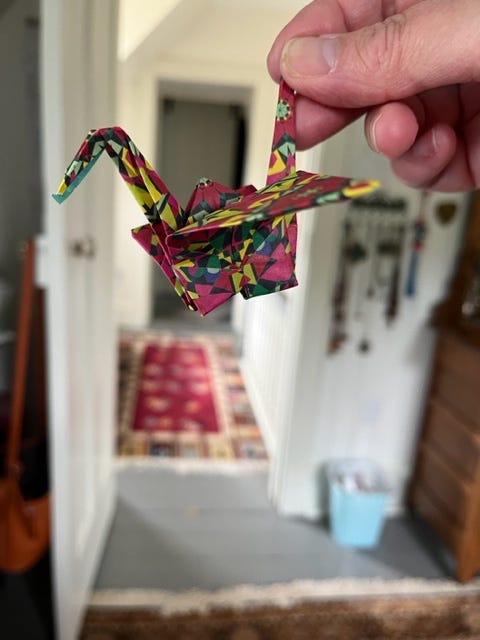
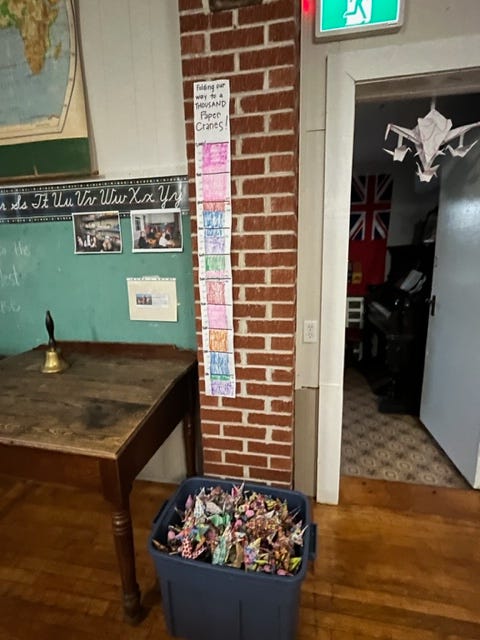

Oh Kathy, the lives you've touched. I'm so proud of you, it's a privilege to share this life journey with you.